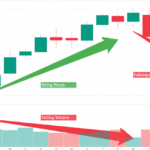By all appearances, Bitcoin is evolving — and so is the way it’s mined. With the latest halving event behind us, the industry stands at a critical juncture. As block rewards shrink and energy concerns grow louder, miners are asking one crucial question: Is Bitcoin mining still sustainable — or are we witnessing the beginning …
Bitcoin Mining in a Post-Halving World: Sustainable or Struggling?

By all appearances, Bitcoin is evolving — and so is the way it’s mined. With the latest halving event behind us, the industry stands at a critical juncture. As block rewards shrink and energy concerns grow louder, miners are asking one crucial question: Is Bitcoin mining still sustainable — or are we witnessing the beginning of a struggle for survival?
⛏️ The Halving: A Built-in Economic Shock
Every four years, the Bitcoin network undergoes a halving — a process that cuts the block reward given to miners in half. In April 2024, Bitcoin experienced its fourth halving, reducing rewards from 6.25 BTC to 3.125 BTC per block.
The halving mechanism is fundamental to Bitcoin’s deflationary model. It creates scarcity, supports price appreciation over time, and mirrors gold’s finite supply. But there’s a flip side: mining profitability can be instantly slashed, pushing smaller or inefficient operations out of business.
⚙️ Mining Economics: Post-Halving Pressures
Mining Bitcoin is a capital-intensive process involving specialized hardware (ASICs), electricity costs, cooling infrastructure, and access to cheap power. The halving tightens margins across the board:
- Break-even Costs Rise: With half the reward, miners must either double their efficiency or hope for Bitcoin’s price to rise significantly.
- Old Hardware Gets Phased Out: Devices like the Antminer S9, once industry workhorses, are now largely unprofitable.
- Energy Price Sensitivity Increases: Miners in high-cost regions are being forced offline or looking to relocate to cheaper jurisdictions.
In essence, only the leanest, greenest, and most strategically located operations survive.
🌍 The Sustainability Question: Environment vs Innovation
Bitcoin mining has long faced criticism over its environmental impact, with energy-intensive proof-of-work (PoW) often labeled as unsustainable. However, post-halving dynamics may ironically be pushing the industry toward greater sustainability:
Green Energy Adoption Rises
- Many miners are now turning to hydroelectric, wind, solar, and geothermal sources, especially in countries like Iceland, Norway, Canada, and even Texas.
- A 2025 report by the Bitcoin Mining Council suggests that over 60% of global Bitcoin mining now uses renewable energy.
Mining as Grid Stabilizer
- Innovative setups now allow miners to act as demand-response mechanisms for power grids, absorbing excess electricity during off-peak hours and shutting down during surges.
Emission Comparisons Shift
- Bitcoin’s energy consumption is still lower than that of gold mining, banking, and even Netflix streaming, according to some studies.
In short, the narrative is shifting: from mining being a climate villain to potentially becoming a force for energy innovation and grid efficiency.
🌐 Global Mining Hubs: Shifting Power Centers
Post-halving realities have also changed the geography of mining:
- The U.S. remains dominant, especially in Texas and Georgia, thanks to deregulated energy markets and pro-crypto stances.
- Kazakhstan and Russia still host a significant share but face increasing political and regulatory risks.
- El Salvador and Bhutan are emerging as nation-backed mining zones, leveraging volcanoes and hydro dams respectively.
These shifts suggest a more decentralized and competitive mining map, which aligns with Bitcoin’s ethos.
💸 Profitability Forecast: What’s the Break Point?
The million-dollar question remains: Can miners still make money?
- At BTC prices below $30,000, many miners struggle to break even unless they have ultra-cheap power or newer, efficient hardware.
- Above $45,000, operations become lucrative again, even for mid-tier facilities.
- Transaction fees are becoming a more important part of miner revenue, especially with Bitcoin Ordinals and layer-2 activity increasing demand for block space.
So, while halving slashes rewards, it also tends to drive up price and on-chain demand — creating a more complex, but potentially profitable ecosystem.
🧠 Adapt or Die: How Miners Are Evolving
To survive post-halving, miners are no longer just “digging digital gold.” They’re diversifying and innovating:
- Co-locating with data centers for AI computing and cloud services.
- Engaging in financial instruments like hash rate derivatives to hedge volatility.
- Building vertically integrated operations with in-house power plants and engineering teams.
It’s a new era of industrial-scale mining — more efficient, better capitalized, and increasingly professional.
🔮 The Road Ahead: Sustainable or Struggling?
Bitcoin mining is not dead — it’s evolving rapidly under pressure. The halving event was a litmus test, and the industry appears to be:
- Shrinking in volume but improving in quality
- Moving toward renewable energy at scale
- Driving innovation in energy and data management
Those who adapt — embracing sustainability, advanced hardware, and smart infrastructure — are not just surviving but thriving.
As Bitcoin’s price, adoption, and network value continue to grow, mining remains a core pillar of decentralization and security. It’s no longer about “mining as usual.” It’s about mining with purpose, efficiency, and resilience.
Bottom Line:
Bitcoin mining in a post-halving world isn’t doomed — it’s transforming. While challenges abound, so do opportunities. If this is a struggle, it’s one that could lead to a stronger, greener, and more future-ready Bitcoin network.







